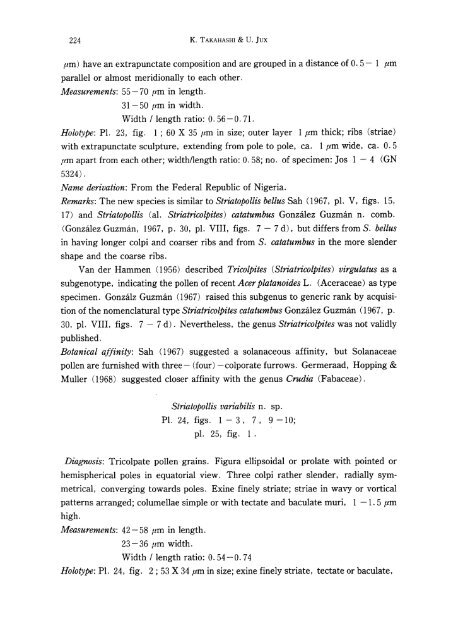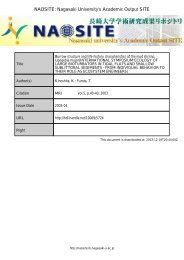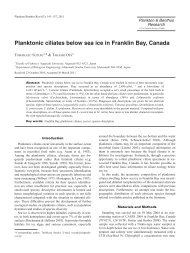Palynology of Middle Tertiary lacustrine deposits
Palynology of Middle Tertiary lacustrine deposits
Palynology of Middle Tertiary lacustrine deposits
Create successful ePaper yourself
Turn your PDF publications into a flip-book with our unique Google optimized e-Paper software.
224 K. TAKAHASHI & U. jux<br />
,urn) have an extrapunctate composition and are grouped in a distance <strong>of</strong> O. 5- 1 ,urn<br />
parallel or almost meridionally to each other.<br />
Measurements: 55 -70 ,urn in length.<br />
31-50 ,urn in width.<br />
Width / length ratio: 0.56-0.71.<br />
Holotype: PI. 23, fig. l; 60 X 35 ,urn in size; outer layer l,um thick; ribs (striae)<br />
with extrapunctate sculpture, extending from pole to pole, ca. l,um wide, ca. 0.5<br />
,urn apart from each other; width/length ratio: 0.58; no. <strong>of</strong> specimen: Jos 1 - 4 (GN<br />
5324) .<br />
Name derivation: From the Federal Republic <strong>of</strong> Nigeria.<br />
Remarks: The new species is similar to Striatopollis bellus Sah 0967, pI. V, figs. 15,<br />
17) and Striatopollis (ai. Striatricolpites) catatumbus Gonzalez Guzman n. comb.<br />
(Gonzalez Guzman, 1967, p. 30, pI. VIII, figs. 7 - 7 d), but differs from S. bellus<br />
in having longer colpi and coarser ribs and from S. catatumbus in the more slender<br />
shape and the coarse ribs.<br />
Van der Hammen (956) described Tricolpites (Striatricolpites) virgulatus as a<br />
subgenotype, indicating the pollen <strong>of</strong> recent Acer platanoides L. (Aceraceae) as type<br />
specimen. Gonzalz Guzman (1967) raised this subgenus to generic rank by acquisition<br />
<strong>of</strong> the nomenclatural type Striatricolpites catatumbus Gonzalez Guzman 0967, p.<br />
30, pI. VIII, figs. 7 - 7 d). Nevertheless, the genus Styz'atricolpites was not validly<br />
published.<br />
Botanical affinity: Sah (967) suggested a solanaceous affinity,<br />
but Solanaceae<br />
pollen are furnished with three- (four) -colporate furrows. Germeraad, Hopping &<br />
Muller (968) suggested closer affinity with the genus Crudia (Fabaceae).<br />
Striatopollis variabilis n. sp.<br />
PI. 24, figs. I - 3, 7, 9 - 10;<br />
pI. 25, fig. I.<br />
Diagnosis: Tricolpate pollen grains. Figura ellipsoidal or prolate with pointed or<br />
hemispherical poles in equatorial view. Three colpi rather slender, radially symmetrical,<br />
converging towards poles. Exine finely striate; striae in wavy or vortical<br />
patterns arranged; columellae simple or with tectate and baculate muri,<br />
high.<br />
Measurements: 42-58 ,urn in length.<br />
23-36 ,urn width.<br />
1 -1. 5 ,urn<br />
Width / length ratio: 0.54 -0.74<br />
Holotype: PI. 24, fig. 2; 53 X 34 ,urn in size; exine finely striate, tectate or baculate,
















